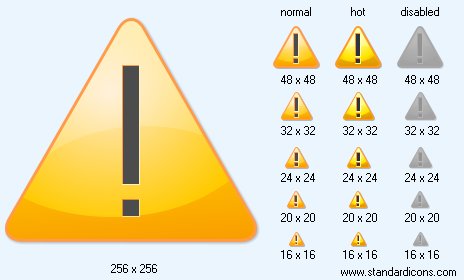


|
| ||||||||
|
|
Warning Icon |
|
Icon sizes: 48x48, 32x32, 24x24, 20x20, 16x16, 256x256, 128x128, 64x64, 512x512
File formats: ICO, GIF, PNG, BMP
Picking The Correct Image File Format In Icon Creation.
There are innumerable image file formats that can be utilized for storing images and for a newbie designer this can often change into a sizable problem because you should know how to use a certain format, here is a a take on the benefits and drawbacks of some well known image formats.If you are interested in icon making or want to create graphical representations for your web page, it is imperative to learn about the various image file formats and their traits so that you can utilize the correct file type for an image. Some of the commonly used file types for pictures are PNG, GIF and JPEG, every one these formats has its own traits so lets discuss the benefits and drawbacks of using these file formats, the type of image format that should live up to the requirements of your website and optimizing your icons for the internet.
GIF: The full form is Graphics Interchange Format; this is one of the more well known file types. The reason for its popularity is its image size that is very small which makes it easy to upload them. But like in the JPEG format, details are not lost in this image format which means you can save the file at just a few bytes and without messing the quality of the picture. Since GIF supports transparency in pictures, it is the most suitable file formats for picture making. Unlike the other file types, animation is also offered in GIF. If you want to go for GIF file optimization, it is important to limit the file size; it is advisable that you choose a 32 color palette to create a suitably small size.
JPEG: This is short for Joint Photographic Experts Group; the image format is generally known as JPG and is usually seen on websites. One of the primary pros of utilizing this type of file is that you can save the graphics in true color that affords you a palette of 16 million colors; making this image type suitable for saving photos and pictures that include detailed color range. One of the problems of utilizing JPG is the loss of details that you will have to deal with every time the image is stored; this points to the fact that the image is marred by clarity issues and a lot of data may be lost. Unlike other file formats such as GIF, support for transparency is not provided in this format. If you have chosen an innovative image editor for instance, the Adobe Photoshop, you will have the liberty to pick the quality and the file size ; however, it is important to comprehend that a lower resolution equates to a smaller size, which is simple to upload.
PNG: Is short for Portable Network Graphics and is a very fresh image format. PNG is provided in two forms; PNG-8 which offers 8 bit color format and the PNG-24 which has 24 color images. PNG-8 can curtail the size graphics with fantastic detail and without the customary loss of data experienced in in GIF images; this results in improved quality pictures and quick uploads. But, PNG-24 is not as efficacious as JPG when you want to store pictures and other images that merit the use of a wider color palette. The image format is loss-less; this means that the photograph holds on to its clarity and quality. PNG-24 offers transparency support and you can include various levels of transparency in this format. When you use this file format the images are smoother because they do not have the tell tale jagged edges when placed in relation to a contrasting background like GIF files.
Copyright © 2009-2022 Aha-Soft. All rights reserved.
|
